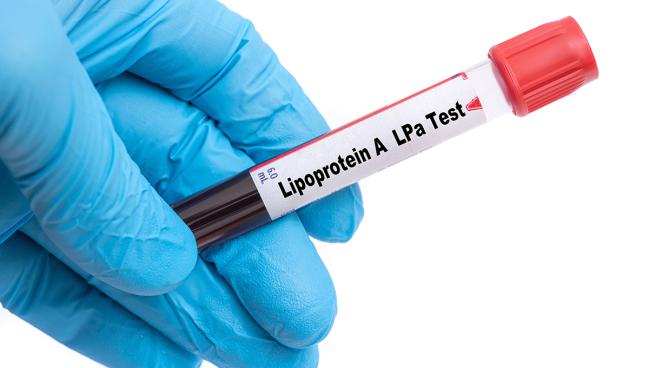PAD, AAA: High Lp(a) Portends Problems Beyond CVD
While the field awaits targeted therapies, estimates of absolute 10-year risks can be used to counsel patients, researchers say.

People with elevated lipoprotein(a) levels see two- to threefold increases in their risks of abdominal aortic aneurysm (AAA), peripheral artery disease, and major adverse limb events, confirms an observational analysis of more than 100,000 individuals from Denmark.
This isn’t the first study to draw these connections, but “the large sample size and complete follow-up of the present Danish general population study enable us to refine previously published risk estimates,” senior author Pia R. Kamstrup, MD, PhD (Copenhagen University Hospital–Herlev and Gentofte, Denmark), told TCTMD in an email.
Moreover, the relationships make sense from a mechanistic perspective, given the known association between high Lp(a) and cardiovascular events.
The Danish researchers found that the added vulnerability to PAD and AAA starts at moderately elevated Lp(a) levels—above 30 mg/dL (61 nmol/L)—and then follows a stepwise pattern. For the one in 100 people with extremely high Lp(a) levels, the risks are more than doubled, Kamstrup pointed out.
This, she said, “translates into high population attributable risks,” such that lowering Lp(a) levels might reduce the incidence of the two diseases by up to 15%.
Current European and Canadian guidelines already recommend once-in-a-lifetime measurement of Lp(a). These new results, published online this week in the Journal of the American College of Cardiology, “stress the importance of aggressively targeting all modifiable conventional risk factors in individuals with elevated Lp(a) levels” to address cardiovascular disease as a whole, as well as PAD and AAA, Kamstrup advised.
Marc P. Bonaca, MD, MPH (University of Colorado School of Medicine, Aurora), chair of the American College of Cardiology Vascular Disease Council, said the observational analysis doesn’t add much new information. Still, “it’s an interesting natural history study,” he told TCTMD.
And more valuably, he added, it’s a reminder that PAD merits attention.
“We know that patients with peripheral artery disease have the worst outcomes, both coronary and limb outcomes,” said Bonaca. This high-risk group stands to gain even more from Lp(a)-lowering than the CVD population at large, he stressed. For instance, subanalyses from the FOURIER and ODYSSEY OUTCOMES trials of PCSK9 inhibitors have shown that these therapies, which in addition to lowering LDL cholesterol can also reduce Lp(a), hold extra benefit for the PAD population.
“That has given the field a lot of hope,” he said.
In the cardiology realm, interest is growing in potential tools to curb elevations in Lp(a), which are mostly determined by genetics. Just last month at the American Heart Association 2023 meeting, phase I data for lepodisiran (Eli Lilly) were the latest to support the small-interfering RNA (siRNA) strategy, following earlier reports on olpasiran (Amgen) and zerlasiran (Silence Therapeutics). Also under study are pelacarsen (Novartis/Ionis Pharmaceuticals), an antisense oligonucleotide (ASO), and muvalaplin (Eli Lilly), an oral small molecule inhibitor.
“As these novel therapies get developed, I think PAD is an important space that people are really excited about,” Bonaca commented. The key going forward will be designing trials that enroll PAD patients specifically and/or track limb events. Current trials “are very coronary focused,” he added. “We need novel therapies, and we need dedicated trials in this population.”
Double to Triple the Risk
Led by Peter E. Thomas, MD (University of Copenhagen, Denmark, and Copenhagen University Hospital–Herlev and Gentofte), the researchers analyzed data on 108,146 adults who took part in the Copenhagen General Population Study between 2003 to 2015. Among them, 2,450 were diagnosed by a hospital with PAD and 1,251 with AAA. A total of 70,317 underwent plasma Lp(a) testing.
Higher Lp(a) levels were linked, in a stepwise fashion, to increased risks of PAD and AAA (both P for trend < 0.001). Compared with individuals at the 50th percentile or below (≤ 9 mg/dL or ≤ 17 nmol/L) for Lp(a), those in the 99th percentile or higher (≥ 143 mg/dL or ≥ 307 nmol/L) had a higher adjusted risk of PAD (HR 2.99; 95% CI 2.09-4.30) and AAA (HR 2.22; 95% CI 1.21-4.07).
Around 11.6% of PAD and 15.0% of AAA diagnoses were estimated to stem from an Lp(a) above the 50th percentile.
Additionally, individuals with PAD were at higher risk of major adverse limb events (defined as thrombectomy, bypass surgery, stenting of the lower-extremity arteries, balloon angioplasty, drug-coated balloon angioplasty, thrombolysis, atherectomy, or lower-extremity amputation), with an incidence rate ratio of 3.04 (95% CI 1.55-5.98).
Nearly all patients underwent genotyping that quantified the LPA KIV-2 number of repeats and tested for LPArs3798220 and rs10455872 single nucleotide polymorphisms, previously shown to explain 48% of the diversity in plasma Lp(a) levels. Here, each 50 mg/dL (105 nmol/L) increase in genetically determined Lp(a) level was linked to a 39% higher likelihood of PAD and a 21% higher likelihood of AAA, both statistically significant.
The absolute 10-year risks of PAD and AAA rose in conjunction with higher Lp(a), and with older age, in both men and women, and in both smokers and nonsmokers. For instance, 21% of women smokers ages 70 to 79 years with an Lp(a) level in the ≥ 99th percentile developed PAD, as compared with 8% of those in the < 50% percentile. For men with the same characteristics, the absolute 10-year risks amounted to 29% and 11%, respectively.
We need novel therapies, and we need dedicated trials in this population. Marc Bonaca
The knowledge that age, sex, smoking status, and Lp(a) level together influence 10-year risk “may be used directly in counseling of individual patients,” Kamstrup said. With no Lp(a)-targeted treatment options yet available, it’s especially crucial to aggressively target any modifiable risk factors that are present.
Referencing the ongoing phase III Lp(a) HORIZON and OCEAN (a)-Outcomes trials, she concluded: “Specific and potent Lp(a)-lowering treatments [now] being tested in large cardiovascular outcome trials, with first results expected in 2025 . . . hold great promise for patients with high Lp(a).”
Joshua A. Beckman, MD (UT Southwestern Medical Center, Dallas), and Alexander E. Sullivan, MD (Vanderbilt University Medical Center, Nashville, TN), in an accompanying editorial, say that this paper builds on earlier reports by linking these clinical manifestations of Lp(a) to the genetic polymorphisms that drive Lp(a) levels.
Although these data are persuasive, “there are many questions to answer before Lp(a) levels become actionable, rather than merely a marker of increased risk,” Beckman and Sullivan say. For instance, assays remain nonstandardized and there’s not yet agreement over what denotes a clinically relevant Lp(a) cutoff.
That said, “Lp(a) is genetically predetermined and stable across an individual’s lifetime, thereby offering the opportunity to risk stratify and offer lifestyle interventions” early in the disease course, they write.
Caitlin E. Cox is News Editor of TCTMD and Associate Director, Editorial Content at the Cardiovascular Research Foundation. She produces the…
Read Full BioSources
Thomas PE, Vedel-Krogh S, Nielsen SF, et al. Lipoprotein(a) and risks of peripheral artery disease, abdominal aortic aneurysm, and major adverse limb events. J Am Coll Cardiol. 2023;82:2265-2276.
Beckman JA, Sullivan AE. Lipoprotein(a), peripheral artery disease, and abdominal aortic aneurysm: the next frontier or another risk enhancer? J Am Coll Cardiol. 2023;82:2277-2279.
Disclosures
- The study was funded by the Department of Clinical Biochemistry, Copenhagen University Hospital–Herlev and Gentofte, Gangstedfonden, and was supported by a research grant from the Danish Cardiovascular Academy, which is funded by the Novo Nordisk Foundation and the Danish Heart Foundation.
- Kamstrup reports lecture honoraria or consultancies from the Physicians’ Academy for Cardiovascular Education, PCSK9 Forum, Silence Therapeutics, and Novartis.
- Thomas reports no relevant conflicts of interest.
- Beckman reports having received research support from Bristol Myers Squibb and consulting fees from Janssen, JanOne, and Novartis.
- Sullivan reports support from the National Institutes of Health/National Institute of General Medical Science.
- Bonaca reports working for CPC Clinical Research, a clinical research organization that does trials with sponsors that include Amgen, Silence Therapeutics, and Novartis.





Comments